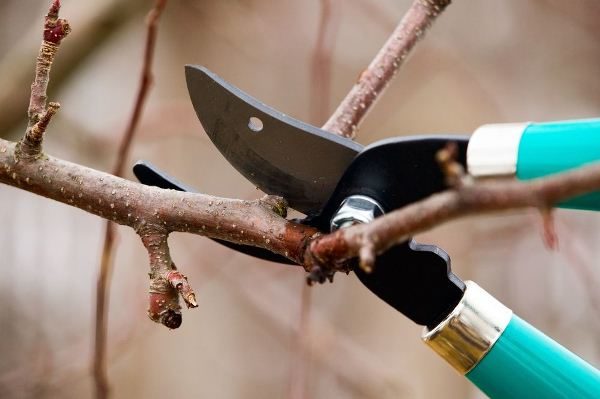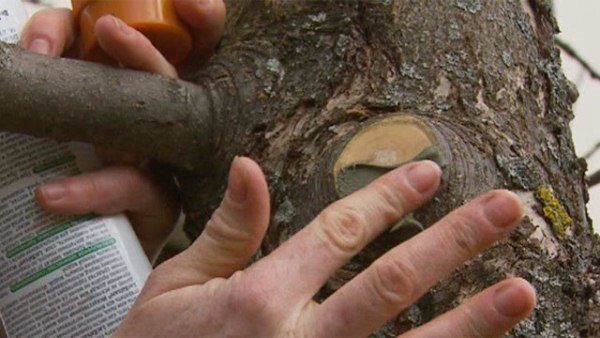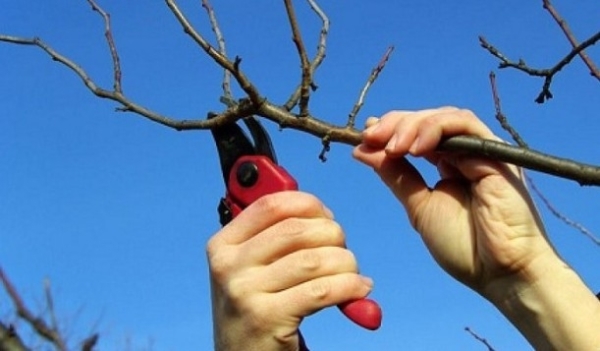Apricot is a tree, characterized by very intensive growth. Due to this feature, crown growth is very fast, which can adversely affect the condition of the whole plant. Often, due to the rapid growth of shoots, apricot tree is exposed to various diseasesmay even dry out and die. To avoid such consequences, you should regularly trim your pet in the fall.
Table of contents
The purpose of pruning apricot
Before considering the aforesaid process, it is necessary to determine why the apricot needs such a procedure. The reasons may be the following:
- Forming a beautiful crown. In this case, cutting is necessary for the aesthetic beauty of the apricot: removing sticking and too long shoots, forming the desired form of the crown of the tree.
- Shoots rejuvenation. Intense fruiting and overly dense crown plants lead to aging and the death of internal shoots.

- In the absence of circumcision fruits are shrinking, and their number is significantly reduced.
- Also without this procedure the branches under the weight of the fruit will break. It is necessary to regulate the number of ovaries on the shoots.
- The growth and development of young twigs is declining, subsequently finally stops. Apricot "grows old", and, as a result, fruits lose their varietal qualities, giving way to size and taste.
- Frosting shoots. If a tree grows in mid-latitudes, it is inevitably exposed to severe frosts.In this case, all the affected or dried branches must be removed for sanitary purposes.
Thus, in order to form a neat and beautiful crown to your pet and ensure regular and abundant fruiting, as well as extend the life of the fruit tree, systematically need to carry out cutting his shoots.
When to prune a tree
If we talk about the appropriate time for pruning the apricot tree, it should be noted that it is necessary to carry out a complex procedure. This means cutting the apricot should be in the fall, summer and spring.
Start the process of cutting branches is recommended in the first year. In the spring begin to form a crownin order to further stimulate abundant fruiting and improve the quality characteristics of the fruit.
Autumn pruning plants for sanitary purposes.. This removes all the sick, damaged and dry shoots for the recovery of the whole tree.

In the summer, pruned branches to stimulate the formation of young shoots. This procedure is carried out for the rejuvenation of apricot with a frequency of once every two or three years.
How to prune an apricot in the fall
In the autumn, the apricot must be cut to remove damaged and unviable branches. In this way, the plant is prepared for the upcoming wintering and help to gain strength for the next season. Also an important result of cutting off weak branches will be the formation of young shoots. Often it is on them that most of the fruits of the apricot tree are formed.
Also a distinctive feature of this fruit tree is that excess ovary is not thrown off by the plant. This leads to the breaking of branches and disease of the plant.
Therefore, in the autumn it is necessary to carry out not only sanitary, but also regulating and rejuvenating pruning.
Preparation of tools
The following tools are needed to care for the apricot tree.:
- pruner;
- garden grafting knife;
- garden saw;
- sharpening bar;
- twine to support shoots and twigs;
- means for embedding sections and wounds (for example, garden var).

First of all garden tools should be carefully sharpened. A garden knife is sharpened in a wet bar to remove iron filings. New pruner, or else blunted, it is necessary to disassemble and sharpen its blade. After that check the tool. The pruner can be adjusted by controlling the tension of the nut: if the grip is too tight, it is loosened; if loose, tighten it.
Before starting work at the garden saw you need to move the teeth in opposite directionsby alternating their slope to the right and left. The angle of bending of the teeth is kept the same, with the sharp side all the teeth should be directed inward.
Trimming scheme and technology
In the autumn apricot forming pruning in the following season, the plant supplies nutrients to the fruit-bearing shoots evenly. That is why this type of pruning is practiced from a young age of trees.
This pruning is carried out in the following way.:
- In the first year of life the trees form a crown, cutting off the whip by a quarter. On the young plant, two main shoots are left, providing a distance of about 30 cm between them, the remaining branches are removed. The remaining branches are cut to a length smaller than the length of the whip by 20-30 cm.
- Next year, two young branches are pruned in a similar way., leaving between them a distance of 40 cm.
- In the following years, the same procedure is carried out.by increasing the gap by 10 cm.
- The branches on the central escape cut by half if they exceed 60 cm long. Short leave unchanged.
- If the apricot tree grew short and weak branches, but they will be able to bear fruit in perspective, they recommend pinching them until they are strong enough to support the weight of the fruit.

Regulatory pruning helps preserve the crown and the productive properties of apricot. In this case, the shoots are removed with the direction of growth inward to the crown to ensure sufficientlevel of illumination of all parts of the plant.
In an adult plant, the growth of new shoots is often suspended. In order to rejuvenate a mature plant, it is subjected to autumn pruning.:
- After a thorough examination of the plant, several non-bearing branches are selected. Their sawed off with a garden saw at an angle 45 degrees.
- Identify several of the most powerful shoots, relatively young. Required remove the branches growing on them, all or several major.
How to care for a tree after trimming
After pruning apricot needs attention. After the procedure it is necessary to carry out the following care steps:
- Close up all sections garden pitch.
- For disinfecting large wounds, use copper sulphate solution.
- For further adaptation and restoration of apricot, phosphate and nitrogen fertilizers are applied.

Proper pruning of an apricot tree may seem like a time consuming process, especially for novice gardeners. But this necessary requirement for plant health and ensuring the required quantity and quality of fruits.
